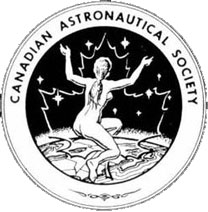Canadian Astronautical Society
From The Space Library
(Disambiguation: Astronautical Society of Canada)
The Canadian Astronautical Society was founded in 1957 by engineers of the Guided Missile Division of the de Havilland Aircraft Company of Canada. The group had gathered to discuss the possibility of building a sounding rocket. Several hours into their first meeting they decided to form an astronautical society. The three reasons cited for the foundation were:
- 1 A potential interest in astronautics seemed to exist
- 2 Canada was unrepresented at the International Astronautical Federation
- 3 Developments in military rocketry made it plain that space travel was rapidly approaching realization and Canadian scientists and engineers did not want to be denied the means of interchange and research in this broad field.
The first meeting was held on January 8th 1958 and attracted 14 people and Dr. Philip A. Lapp was elected President by acclaim. Further meetings were attended by approximately two dozen enthusiastic engineers and in March of 1958 the first meeting at which a large number of persons from many other companies and organisations was convened. At this meeting a motion was unanimously carried that the Society should be legally incorporated as a non-profit making professional organisation with limited liability and active in the field of astronautics.
The objectives of the Society provided for experimental as well as theoretical studies and consequently an experimental program was initiated.
The first project was the design, development and construction of a complete high altitude research rocket system including all ground instrumentation and handling equipment. Excellent progress was made in the first year on a purely voluntary basis and was conditional upon the authorities making available the facilities of a military range, the rocket was expected to be ready for firing by late 1959. A helical antenna for satellite tracking was built with volunteer money and was completed in October 1958, making it almost certainly Canada's first satellite tracking station.
Ten meetings were held in the first six months where experts of high standing delivered addresses to the membership. Exhibitions of rocket equipment built by members were also featured.
Branches of the group included a Space Dynamics Group headed by Howard S. Kerr. This group concerned itself with tracking satellite orbits as part of Fred Whipple's Operation Moonwatch. An Analysis Group composed of professional mathematicians and physicists handled data reduction and numerical work of projects carried out by the society. The Propulsion Group designed and developed combustion chambers and rocket motors as well as the ignitor devices. The Mechanical Group handled design and stress analysis as well as building scale models. An Electronics Group handled communication and telemetry and firing circuits. The Recovery Group investigated means for safely recovering the instrumented payloads. A Space Medicine Group studied man's ability to withstand external forces and strange environments. The Space Law Group was concerned with territorial claims at high altitude.
Copies of the Society Proceedings were to be published quarterly and an annual general meeting would be held every January.
In August 1958 during the 9th International Astronautical Congress in Amsterdam, Holland, the Canadian Astronautical Society became the first Canadian organisation to be recognised as a member of the International Astronautical Federation.
By February 1959 the CAS had over 200 members with affiliations from 40 companies, universities and government facilities. At this time eight field trials concerning the static firing of the research rocket had been undertaken as well as parachute drops for recovery tests.
The sounding rocket was named Project CHARM which stood for Canadian High Altitude Research Missile.
Dr Phillip A. Lapp, President of the Canadian Astronautical Society speaks at the first annual meeting, January 23rd 1959
Founding Officers of the Society:
- Dr Philip A. Lapp - President - Project Engineer De Havilland Guided Missile Division
- Arthur E. Maine - Secretary - Senior Electronic Development Engineer De Havilland Guided Missile Division
- Raymond R. Taylor - Treasurer - Electrical Engineer De Havilland Guided Missile Division
- James D. Bain - Councillor - Technical Manager Canadian Arsenals Ltd
- Austen B. Barnes - Councillor - Development Engineer De Havilland Guided Missile Division
- James A.C. Henderson - Councillor - Senior Development Engineer De Havilland Guided Missile Division
- Stuart R. Oney - Councillor - Project Engineer De Havilland Guided Missile Division
- David C. Wallis - Councillor - Senior Weapon System Analyst Avro Aircraft Company Ltd
In December 2nd and 13th of 1960 Dr. Philip A. Lapp met with Charles Luttman, the Permanent Secretary of the Canadian Aeronautical Institute in Ottawa to discuss the terms of a merger between the two organisations.
The CAS would merge with the Canadian Aeronautical Institute at a joint conference in Montreal in October 1961 to become the Canadian Aeronautics and Space Institute.




